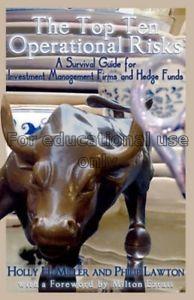The top ten operational risks :a survival guide for investment management firms and hedge funds /Holly H. Miller and Philip Lawton ; with a foreword by Milton Ezrati
Author : Miller, Holly H

More than ever before, institutional investors and their consultants are probing investment management firms’ risk management policies and procedures. Beyond market, credit and liquidity risk, their concern extends to investment managers’ back- and middle-office functions. For example, investors and consultants are asking: • Is the firm managed and staffed by qualified people? • Are workflows properly documented and consistently followed? • Are employees cross-trained to handle one another’s jobs? • Does the firm keep track of collateral in the hands of prime brokers? • How does the firm plan ahead for changes in the regulatory and competitive environment? In the aftermath of the global financial crisis, clients and prospects want to know the answers to these and many other questions. And they will not entrust assets to organizations whose day-to-day operations are chaotic or whose long-term business prospects are doubtful. “In worst-case scenarios, an investment firm’s failure to identify and mitigate operational risk can result in significant direct costs and a devastating loss of reputation,” write Holly H. Miller and Philip Lawton. “It may take years to reassure investors, regulators and trading partners that the firm is well-managed.” Internationally known as dynamic speakers and engaging writers, the authors of The Top Ten Operational Risks draw upon their extensive practical experience to offer clear, compelling and—above all—useful advice about how to recognize and lessen the risk of loss due to inadequate internal processes, people and systems or external events. Starting with complacency on the part of senior management, each of this book’s central chapters addresses one of the ways in which investment management firms may be exposed to unwelcome surprises. There are succinct, readable essays on staffing, training and the special attention due hand-offs among individuals, teams, systems and external service providers. Other chapters focus on technology, workflows and aspects of the segregation of duties that are especially significant in the investment management industry, such as observing the distinction between the firm and the funds it manages. The authors additionally bring their experience to bear on reconciliation gaps, the importance of knowing the firm’s counterparties and the regulatory regimes to which they are answerable, and the challenges of effective strategic planning in a rapidly changing marketplace. C-level executives and middle managers in sales and marketing, client and consultant relations, compliance, human resources and internal audit will find The Top Ten Operational Risks intriguing. Their colleagues in risk management and investment operations will find it indispensible. As Milton Ezrati writes in the foreword, “The investment of an hour or two will offer managers numerous ways to improve their firm and their client service and, critically, a means to guard against rather large, unexpected expenses.”
| Barcode | Call No. | Volume | Status | Due Date | Total Queue | |
|---|---|---|---|---|---|---|
| 1040002703 | IK00040 | On Closed Stack | 0 | Please Login |
Related Book